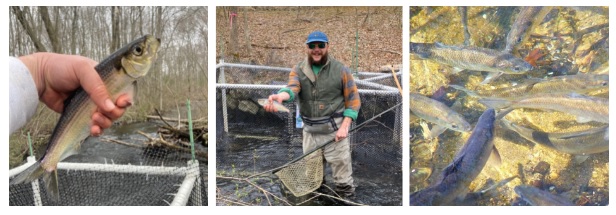Fish are Running…But Not at Kinneytown
by savethesound.org
It’s officially spring, and migratory fish are making their way upstream to spawn. Some have been successful, like those in Whitford Brook, while others are encountering insurmountable barriers.
The spring fish run is an important time of year for diadromous fish that migrate from Long Island Sound into rivers throughout Connecticut and New York to their ancestral spawning grounds. Reproduction of fish such as alewife, blueback herring, and sea lamprey is important not only to sustain these species, but also to support populations of larger fish, birds, and mammals that rely on these “forage fish” for food.

The first alewife caught in traps between Whitford Pond and Long Pond (left). Fish biologist, Jon Vander Werff holds an alewife (middle). A school of alewife (right)
Dams and other barriers in our rivers hinder this important migration, and one of the largest culprits in the Long Island Sound region is Kinneytown Dam on the Naugatuck River. While a fishway was installed at this location, it has never been effective and has not even been opened yet this year by Hydroland, the dam owner. Their inability to pass the dam leaves fish stranded, forcing them to turn around or die from predation or exposure. Save the Sound’s Ecological Restoration team will be examining environmental DNA in the water at the base of the dam to understand which fish species are trying, and failing, to pass this barrier this year.
But it’s not all bad news. Whitford Brook has seen alewife make their way up through a natural breach in the Whitford Pond Dam to stretches of the river below Long Pond Dam (where Save the Sound is currently designing a nature-like fishway) for the first time in centuries.
“I’m so excited about this little fish—it is the first alewife documented that high in the watershed since before the construction of the Hyde Pond Dam,” says fish biologist Jon Vander Werff. “These fish are now able to reach habitat that hasn’t been accessible in hundreds of years, giving new life and new possibilities to the Whitford Brook diadromous fish run.” Save the Sound led the removal of Hyde Pond Dam in 2015.